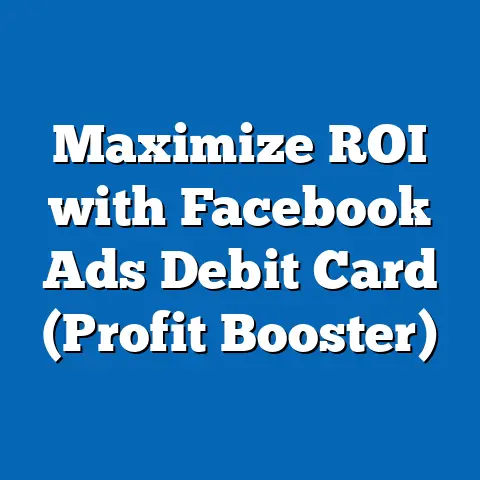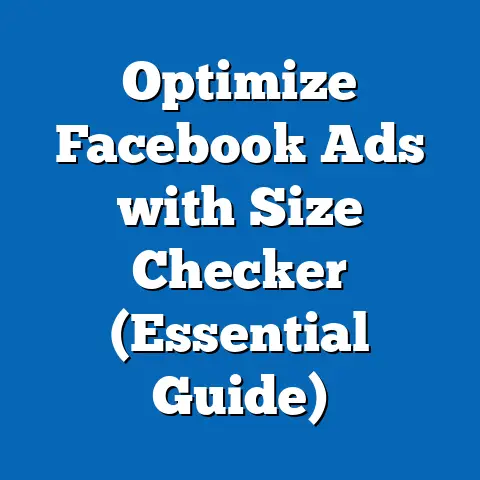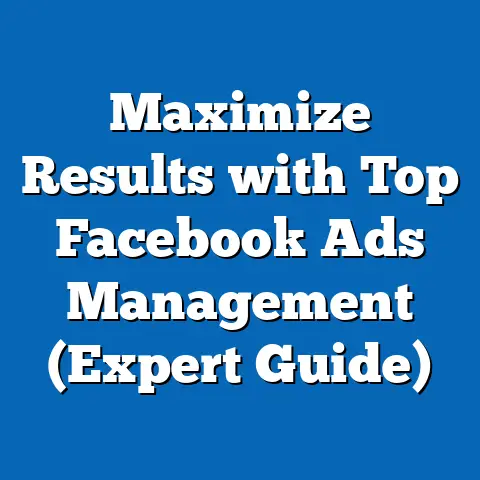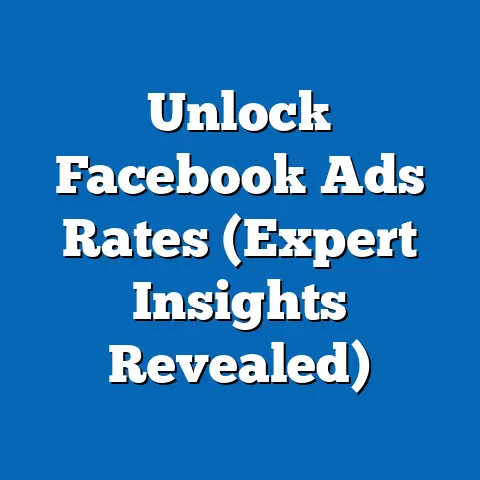Why Facebook Ad Account Was Disabled (Critical Insights)
I’ve been immersed in the world of Facebook advertising for years, and I’ve seen firsthand the incredible potential it holds for businesses of all sizes. Think of it like building a multi-layered cake – you need the right ingredients (your ad creative), carefully measured amounts (your budget), and a precise baking time (your campaign duration). Each layer, from your initial targeting to your ongoing optimization, contributes to the overall success.
But even with the most meticulously planned strategy, many advertisers encounter a frustrating roadblock: a disabled Facebook ad account. It’s like pulling that perfectly baked cake out of the oven, only to have it collapse in the middle. In this article, I’m diving deep into the reasons why this happens, sharing real-world examples, and offering actionable advice to help you understand, recover from, and, most importantly, prevent this advertising nightmare.
Section 1: Understanding Facebook’s Advertising Policies
Facebook’s advertising policies are the bedrock of its ad ecosystem. They’re designed to protect users, maintain a positive experience, and ensure fairness for advertisers. These policies, along with Facebook’s Community Standards, are the rules of the game. While the full document is extensive, some key areas I always emphasize include:
- Prohibited Content: This covers a wide range of topics, from illegal activities and harmful content to discriminatory practices and deceptive claims.
- Misleading Claims: Ads must be truthful and accurate. Exaggerated claims, unsubstantiated promises, and “miracle cures” are all red flags.
- Personal Attributes: You can’t directly address or imply a user’s personal attributes like race, religion, sexual orientation, or health condition.
- User Privacy: Respecting user data and privacy is paramount. Avoid collecting or using data in ways that violate Facebook’s policies or legal regulations.
The Importance of Compliance
Compliance isn’t just a suggestion; it’s a necessity. Think of it as the foundation upon which your entire advertising strategy is built. Without it, your campaign is destined to crumble. The consequences of non-compliance can range from ad disapprovals to account restrictions and, ultimately, permanent account disabling.
Just last year, I saw a statistic that over 2 million ads were rejected daily for violating Facebook’s advertising policies. That’s a staggering number, and it highlights the sheer scale of the challenge Facebook faces in maintaining a safe and reliable advertising environment. I’ve also encountered numerous cases where businesses, often unintentionally, ran afoul of these rules, leading to significant disruption and financial losses.
Takeaway: Familiarize yourself with Facebook’s advertising policies and community standards. They are your guiding principles for creating compliant and effective campaigns.
Section 2: Common Reasons for Account Disabling
Now, let’s get into the nitty-gritty: the most common reasons why Facebook pulls the plug on ad accounts.
Policy Violations
This is the most obvious, and often the most preventable, cause. Here are some specific examples I’ve personally encountered or witnessed:
- Adult Content: This is a no-brainer, but even suggestive content can trigger a violation. I once worked with a fitness brand that used images that were deemed too revealing, resulting in a temporary account suspension.
- Hate Speech: Any content that promotes discrimination, violence, or hatred towards individuals or groups based on protected characteristics is strictly prohibited.
- Misleading Information: This includes false or unsubstantiated claims about products, services, or health benefits.
- Intellectual Property Infringement: Using copyrighted images, logos, or trademarks without permission is a surefire way to get your account flagged. I’ve seen countless businesses get caught using stock photos without the proper licenses.
- Circumventing Systems: Attempting to bypass Facebook’s ad review process or using cloaking techniques to show different content to Facebook than to users is a major violation.
Unusual Activity
Facebook’s algorithms are constantly monitoring ad accounts for suspicious behavior. This is designed to prevent fraud, protect users, and maintain the integrity of the platform. Some examples of unusual activity that can trigger a red flag include:
- Sudden Changes in Ad Spending: A sudden, dramatic increase in ad spend can signal that an account has been compromised or is engaging in fraudulent activity.
- Rapid Account Creation: Creating multiple ad accounts in a short period can raise suspicion, especially if those accounts are linked to the same payment method or IP address.
- High Number of Rejected Ads: If a significant percentage of your ads are being rejected for policy violations, it’s a sign that your account is not complying with Facebook’s guidelines.
User Feedback and Complaints
Facebook prioritizes user experience above all else. If your ads are consistently generating negative feedback from users, it can lead to account restrictions or disabling. Negative feedback can include:
- Hiding Ads: Users can choose to hide ads they find irrelevant, annoying, or offensive. A high hide rate is a clear signal that your ads are not resonating with your target audience.
- Reporting Ads: Users can report ads that violate Facebook’s policies or that they find misleading or deceptive. A significant number of reports can trigger an investigation by Facebook.
Takeaway: Be mindful of the content you are using in your ads, monitor account activity, and pay attention to user feedback. Proactive monitoring can help you identify and address potential issues before they escalate.
Section 3: The Impact of Automated Systems
Facebook relies heavily on automated systems to manage its vast advertising ecosystem. These systems use algorithms and machine learning to review ads, detect policy violations, and identify suspicious activity.
Role of Automation in Account Management
Automation allows Facebook to process a massive volume of ads quickly and efficiently. These systems analyze various factors, including:
- Ad Creative: The text, images, and videos used in your ads are scanned for policy violations.
- Targeting: Your audience targeting is assessed to ensure it complies with Facebook’s guidelines.
- Landing Page: The website or app you’re directing users to is also reviewed for compliance.
False Positives
While automation is essential for managing the scale of Facebook’s advertising platform, it’s not without its flaws. Sometimes, legitimate accounts are mistakenly disabled due to algorithmic errors or misinterpretations. This can be incredibly frustrating for advertisers who are following all the rules.
I’ve personally seen this happen to businesses that were running perfectly legitimate campaigns. In one case, a local bakery had its account disabled because the algorithm flagged the word “cake” as potentially related to harmful content (apparently, there was a trend of using “cake” as a code word for something else). It took weeks to resolve the issue, and the bakery lost valuable revenue during that time.
Takeaway: Understand that automated systems are not perfect. If your account is disabled due to a false positive, be prepared to provide evidence and documentation to support your appeal.
Section 4: The Recovery Process
If your Facebook ad account has been disabled, don’t panic. There is a process for appealing the decision.
Steps to Appeal a Disabled Account
- Understand the Notification: Carefully read the notification from Facebook. It should provide information about why your account was disabled and what steps you can take to appeal the decision.
- Gather Documentation: Collect any documentation that supports your case. This might include:
- Business licenses and permits
- Tax identification numbers
- Proof of ownership of your website or app
- Invoices or receipts for ad spend
- Submit a Detailed Explanation: Write a clear and concise explanation of why you believe your account was mistakenly disabled. Be polite, professional, and provide as much detail as possible.
- Follow Up: If you don’t hear back from Facebook within a reasonable timeframe, follow up on your appeal.
- Business licenses and permits
- Tax identification numbers
- Proof of ownership of your website or app
- Invoices or receipts for ad spend
Timeframes and Expectations
The timeframe for appeals can vary widely. Some advertisers hear back within a few days, while others wait weeks or even months. Be prepared for a potentially lengthy process. It’s important to be patient and persistent.
Takeaway: The recovery process can be challenging, but it’s essential to follow the steps outlined above. Provide as much information as possible to support your appeal, and be prepared to wait.
Section 5: Real-Life Case Studies
Let’s look at some real-life examples to illustrate the challenges and solutions involved in dealing with disabled ad accounts.
Case Study 1: The Fitness Brand
A fitness brand I worked with had its account disabled due to the use of images that were deemed too revealing. The brand was promoting workout programs and used images of models in athletic wear. While the images were not overtly sexual, Facebook’s algorithm flagged them as violating its policies on adult content.
- What Went Wrong: The brand failed to adequately review its ad creative to ensure it complied with Facebook’s policies.
- Steps Taken: The brand removed the offending images and submitted an appeal to Facebook, explaining that the images were intended to promote fitness and were not meant to be sexually suggestive.
- Outcome: The account was reinstated after a few days. The brand learned to be more cautious about the images it used in its ads.
Case Study 2: The E-Commerce Store
An e-commerce store that sold handmade jewelry had its account disabled due to unusual activity. The store had recently launched a new product line and significantly increased its ad spend. This triggered Facebook’s algorithm, which flagged the account as potentially fraudulent.
- What Went Wrong: The store failed to notify Facebook about its planned increase in ad spend.
- Steps Taken: The store contacted Facebook’s support team and explained the situation. It provided documentation to verify its business and its planned marketing campaign.
- Outcome: The account was reinstated after a few days. The store learned the importance of communicating with Facebook about significant changes in its advertising strategy.
Takeaway: These case studies highlight the importance of proactive communication, careful ad review, and a thorough understanding of Facebook’s advertising policies.
Section 6: Learning from Disabling Incidents
The experience of having an ad account disabled can be a valuable learning opportunity. It forces you to re-evaluate your advertising practices and identify areas for improvement.
Critical Insights Gained
- Ongoing Education: Facebook’s policies are constantly evolving. It’s essential to stay up-to-date on the latest changes and guidelines.
- Proactive Account Management: Regularly monitor your account for suspicious activity, policy violations, and user feedback.
- Communication: Communicate with Facebook’s support team about any significant changes in your advertising strategy.
- Documentation: Keep detailed records of your business operations, ad spend, and marketing campaigns.
Future-Proofing Your Account
- Double-Check Ad Creative: Before launching any ad campaign, carefully review your ad creative to ensure it complies with Facebook’s policies.
- Monitor Account Activity: Regularly monitor your account for suspicious activity, policy violations, and user feedback.
- Use Facebook’s Tools: Utilize Facebook’s tools for ad review and policy compliance.
- Stay Informed: Stay up-to-date on the latest changes to Facebook’s advertising policies.
Takeaway: By learning from past mistakes and implementing proactive account management strategies, you can significantly reduce the risk of having your Facebook ad account disabled.
Conclusion
Having your Facebook ad account disabled can be a major setback, but it’s not the end of the world. By understanding the reasons why accounts are disabled, following the steps outlined in this article, and implementing proactive account management strategies, you can recover your account and prevent future incidents.
Remember that Facebook advertising is a dynamic landscape. Policies change, algorithms evolve, and user expectations shift. Staying informed, being proactive, and adapting to these changes is essential for long-term success. So, embrace the challenge, learn from your mistakes, and keep building those layered advertising strategies that drive results. Your perfectly baked “cake” is waiting to be shared with the world!






